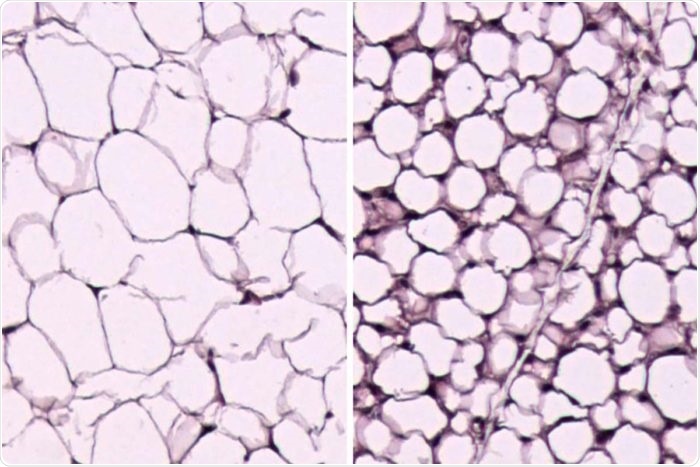Researchers have found that the unhealthy fat in the body called “white fat” could be converted to a healthier fat by blocking a special protein. This could help fight the obesity epidemic they speculate. The report was published in the journal Cell Reports.
White, brown and beige fat
There are two types of fat in the body – white and brown.
- The white fat is the one that stores the energy and gives rise to layers of the fat that gets accumulated in certain parts of the body including the central regions. It contains large droplets of triglycerides and these are the source of energy when the body is fasting.
- In brown fat, the fat droplets are much smaller. They also have cellular powerhouses called the mitochondria. These mitochondria break down the brown fat to produce energy more readily compared to white fat.
Newborn babies have more brown fat than white and this helps protect them from the surrounding cold temperatures. As a person reaches adulthood, much of this brown fat is lost. One of the significant understandings of these body fat types is an attempt to convert this white fat to brown so that it can be readily burnt off. This happens naturally when a person is exposed to cold temperatures but otherwise was deemed difficult. This conversion was thought to be the treatment for diabetes and obesity.

Working in mice, researchers at Washington University School of Medicine in St. Louis have identified a way to convert white fat, which stores calories, into brown fat that burns them. Above are white fat cells from a normal mouse (left) and from a mouse lacking the PexRAP protein (right), which interferes with the conversion of calorie-storing fat cells into calorie-burning cells. The fat cells without PexRAP store fewer calories and look more like brown fat cells. Image Credit: IRFAN J. LODHI
Apart from white and brown, scientists also found a “beige fat” in 2015 among adults. This was found to be half way to brown fat and showed similar beneficial behaviors such as brown fat.
The study
Researchers tried to convert the white fat into a “beige fat”. This could help reduce weight. Dr Irfan Lodhi, from Washington University School of Medicine in St Louis, who was one of the leading authors said that the aim of the study was to find how to treat and prevent weight gain and obesity. For this the team targeted a protein in white fat to convert it to beige.
The team of researchers blocked a protein called the PexRAP in white fat. This caused the white fat in the lab mice to turn beige. They created a special genetic strain of the lab mice. These mice did not have a key protein in their white blood fat cells. Thus they developed more beige fat and also had a leaner body when compared to other mice and despite having the same diets as other mice. These genetically modified mice seemed to have a better metabolism than other mice and thus burnt more calories.
Lodhi said that mice had low levels of the protein normally in their brown fat. If the normal mice were put in a cold environment, the levels of the protein in their white fat also decreased and the white fat acted like brown. Cold was also found to induce the brown and beige fats to burn the stored energy and produce heat.
Authors suggest that as a next step they needed to find a way how to block this protein within the fat cells of a human being. Lodhi explains that this needed to be done in a manner that was safe for the recipient and not cause the body to heat up or develop fever.
The study was supported by the National Institute of Diabetes and Digestive and Kidney Diseases of the National Institutes of Health (NIH).